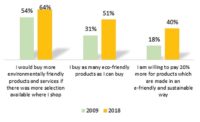When NMI began conducting research on the eco-marketplace in 2002, sustainability was novel enough that it was only relevant to approximately 20 percent of the population. In the past 15 years, sustainability has mainstreamed, and now over 80 percent of U.S. adults are somehow engaged in sustainability. In fact, mainstream consumers are steadily adopting stronger environmental and sustainable ideals that are affecting not only how they view brands, but how they use their buying dollars to make their beliefs known. Therefore, almost all products and services going forward will need to consider consumer motivations regarding eco-friendliness.
However, it is important to understand that consumer segments in the general population exhibit various shades of “green” based on their levels of environmental and sustainable engagement. By understanding each consumer segment’s orientation, organizations are better equipped to determine how to target the most-optimal segment with the most-relevant communications strategy.
In order to better understand the differences in how these consumers engage in the sustainable marketplace, NMI has developed a consumer segmentation model which identifies five consumer segments: LOHAS, Naturalites, Drifters, Conventionals and Unconcerned.
The consumer segment within the population which is considered the “greenest” segment is the LOHAS segment (“Lifestyles of Health and Sustainability”). LOHAS consumers are typically the most-attractive population to green marketers. Not only are they more aware of environmental issues, they are willing to consider the consequences of what their actions and purchases have on the environment.
The LOHAS consumer segment is integral in helping drive sustainability into the mainstream. The LOHAS consumer seeks out products, services and brands that align with their environmental and social values and will influence others to use them. As mainstream consumers become more aware of various products, they try them, and oftentimes adopt them. And the cycle continues as the LOHAS consumer discovers more products and services that align with their values and drive them into the mainstream. Hence, LOHAS consumers are a critical target for companies marketing green, socially responsible or healthy products, as their buy-in is fundamental to reaching other consumer segments.
LOHAS consumers show a strong commitment to healthy eating. Four out of five (81 percent) agree that “eating healthy is a vital part of my life,” compared to only 68 percent of the general population. Similarly, 92 percent of LOHAS consumers believe that consuming healthy, nutritious food is important in maintaining a balanced lifestyle, versus 79 percent of the general population. To that end, LOHAS consumers are heavier users of “healthy” categories (the table highlights the gap between LOHAS consumers and the general population for some key healthy categories).
While LOHAS consumers have a voracious appetite for eco-friendly products, their wants and needs continue to evolve. Products that meet their needs today will likely need to be “re-invented” in three to five years. They are also looking to connect morally with companies, which raises the bar on what and how much companies communicate about who they are and what they stand for. As more consumer segments find their own path to living “green,” the products and services available must fit varying lifestyles. Companies that are able to meet consumer needs, regardless of their shade of green, will realize the most success.





